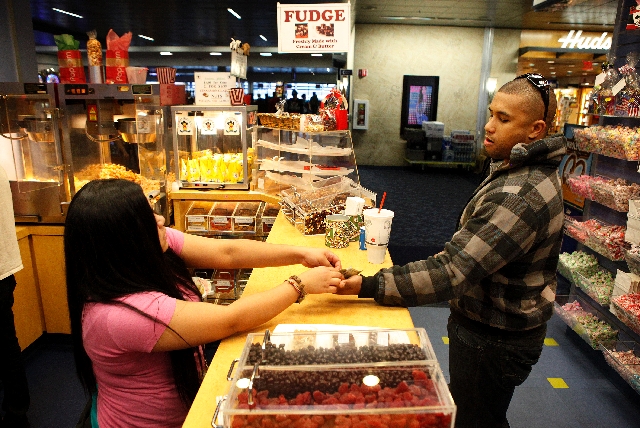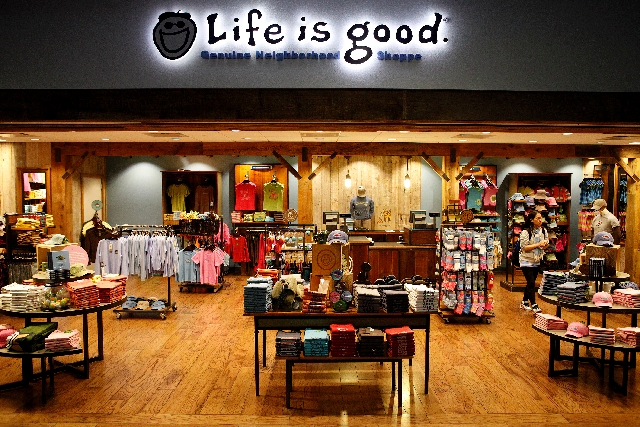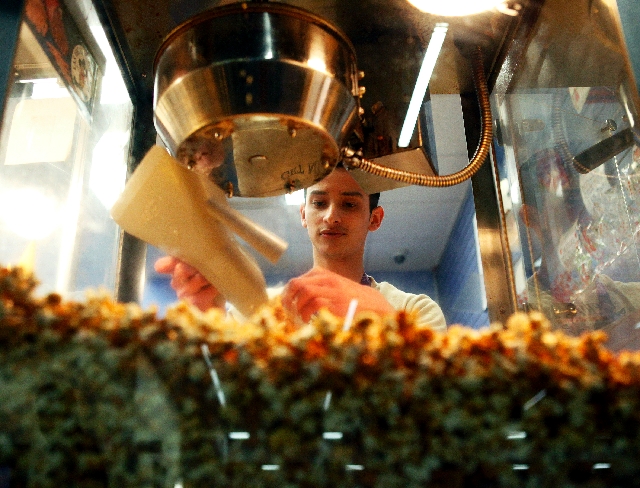Retailers must master unusual obstacles to thrive at airport
When McCarran International Airport managers receive a store proposal promising rent far higher than the norm, it’s a good sign that the number is based on a stereotype.
To many people who have only bought something at an airport, the selling appears to be the most idiot-proof niche in retailing. With a huge captive market — 42 million people a year at McCarran — delivered without spending a dime on advertising, all a store owner apparently has to do is stock the shelves, charge airport prices, turn on the lights and watch the profits walk in.
But those familiar with experience paint a different picture.
“Anyone who comes in with that attitude (that it’s easy) will probably not be very successful,” said Randall Walker, the director of the Clark County Department of Aviation, which operates McCarran.
Complicated construction logistics, higher rents than a neighborhood shopping center, regular report cards from McCarran staff and disruptive forces ranging from airline mergers to East Coast blizzards all contribute to a unique business environment.
The sales for the three franchised Port of Subs at McCarran generate the highest sales in the Reno-based chain of 150 sandwich shops, said President Mike Powell, and help spread name recognition quickly. However, the traffic can vary widely day-to-day and longer term, far beyond what happens at regular stores.
“You have to be really flexible,” he said. “In our case, there certainly have been peaks and valleys. At a traditional Port of Subs, you don’t have to have employees on standby that can be called in on a moment’s notice” because of weather-related delays that spur a surge in demand.
Finding owners who understand or can adapt to an airport is critical to ensuring that McCarran can meet its goal of keeping at least half of its 62 specialty retail locations in locals’ hands. Over the next three years, 15 spots will go through a request for proposals process, including some where the incumbents will be trying to stay in place.
HMSHost oversees the 99 restaurant and bar locations through a different process that also encourages local participation.
McCarran managers place a high emphasis in their evaluations on how much rent a store might produce to help pay for general operations and hold down the fees and rents charged to airlines, a way to make it financially attractive for them to add flights. But they and the committees that evaluate proposals also try to get it right the first time to avoid having to evict merchants and replace them, which costs the airport money, Walker said.
A committee with a mixed membership of airport officials and outsiders will rate a proposal on a point system. Different numbers are awarded for categories such as potential rent, strength of concept, the owner’s business background and financial wherewithal. Then, the verdict will go to the Clark County Commission for final approval.
Up front, Walker said, “We give historic patterns for a location. We don’t guarantee a traffic level.”
For example, the Mr. Boxer clothing store near one of the security checkpoints to Concourse C recently closed as foot traffic dwindled substantially after a different checkpoint opened. Business dropped sharply at the rotunda entrance to concourses A and B after US Airways began dismantling its former hub about four years ago and other airlines were shifted to Terminal 3 last year. McCarran’s current retail plan calls for leaving 11 spaces empty for now because of sparse traffic.
McCarran avoids copycats, at least in the same area. The airport will not, for example, put three fried chicken brands in the same food court.
Also, said Walker, faddish product lines or concepts do not play out well, given that the standard lease runs five years. He recalled that McCarran once had a store where everything cost $10, a trend that was popular when it opened but fizzled badly about midway through the lease.
Potential retailers also have to understand that the customer pool is not nearly as large or captive as it might seem at first, Walker said. Half of McCarran’s 42 million annual passengers are arriving in Las Vegas, and stop mostly to grab baggage before heading to the exit. Even people waiting for departing flights are not sure sales.
“Not many people who go to an airport plan to shop. They just want to leave,” Walker said. “You really have to provide them a reason to shop” through merchandise selection and display.
The passengers are also spread over four concourses in Terminal 1 and Terminal 3, so only a fraction will ever pass a particular location.
The location can influence where stores wind up. Upscale brands Coach and Brooks Brothers have stores at the Concourse D wing used by Delta Air Lines, which pitches itself to a business clientele. Those shops might not do well near Spirit, which promotes low fares and no amenities for bargain-hunting tourists.
Kathy Hussey bought the three Las Vegas Fruits and Nuts locations — two stands and one store — in 2004 after working more than a decade for a different airport retailer. “I love working for myself,” she said.
She has seen wide fluctuations in traffic, notably a steep drop at the A/B rotunda.
“If I had only one location, it would be real tough,” she said.
But with three, she can rebalance the business as needed to stay on an even keel overall.
The reputation her fruits and nuts have built among locals has prompted her to sell online and open her first store outside the airport, so customers don’t need a plane ticket just to buy a bag of cashews.
As president of the Molasky Group of Cos., Richard Worthington has a long resume in construction. But in building the Liquor Library package at the Terminal 1 baggage claim, he faced unfamiliar circumstances.
Contractors that worked on the store needed to carry $5 million in auto liability insurance, not the standard
$1 million. Everyone needed a credential, even though the location is outside the secure zone. The staging area for materials had to be remote instead of right by a front or back door, as is typical with a shopping center.
“Imagine if you bought a dishwasher and the delivery guy had to park a half mile away, then had to go back there if he needed some more tools,” said Worthington, who co-owns Liquor Library.
After four months of operation, the sales have been slower than initially projected, compounded by what he termed “a pretty steep rent structure.”
But he credits airport management for working with him to improve results.
“Business has not been as great as we thought it would be,” he said. “But we’ll get there.”
The promise of airport retail is bright enough that Las Vegas-based Capriotti’s is scouting locations.
“Airports are a natural next step for us,” Capriotti’s President Patrick Walls said. “We already operate in casinos, so we are familiar with the food court environment.”
Besides the financial contributions, he sees airports as a marketing tactic, exposing the brand not only to more customers but potential franchisees.
HMSHost, which operates several brands and oversees subleases, advises even experienced retail entrepreneurs to listen.
“When you hitch your wagon to a national operator, let them help you,” marketing director Jill Nidiffer said.
This can be harder than it sounds because many mom and pop restaurants and bars are used to running the business their way.
She also cautioned that inventory management could take time to master because what sells well in a neighborhood might not be popular in an airport.
“You have to be careful to be a good business operator,” said Worthington. “It is far from idiot-proof.”
Tim O’Reiley can be reached at 702-387-5290 or at toreiley@reviewjournal.com
Information about McCarran concessions can be found at: https://www.mccarran.com/DoingBusiness/Concession.aspx



















